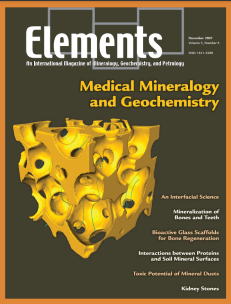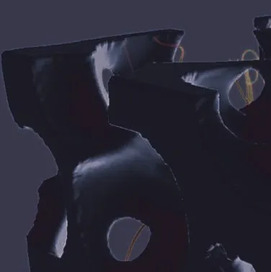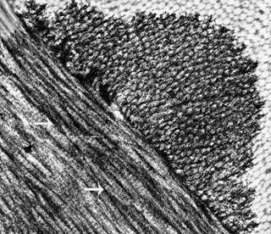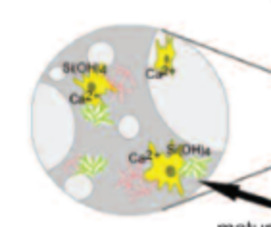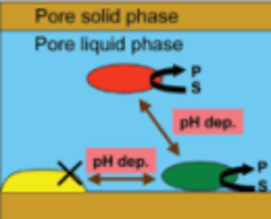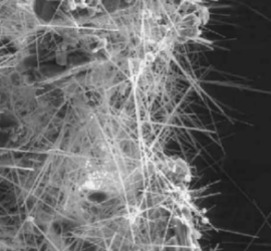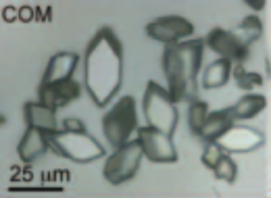
Medical Mineralogy and Geochemistry
Nita Sahai – Guest Editors
Table of Contents
Medical mineralogy and geo- chemistry is an emergent, highly interdisciplinary field concerned with both normal and patholog- ical interactions between miner- als or amorphous inorganic solids and biomolecules or cells within the human body, and the transport and fate of prions and protein toxins in the soil envi- ronment. Prior research has, appropriately, focused on the complex genetic and molecular biological aspects, but there is a growing recognition of the vital need for understanding the sur- face and bulk properties and reactivities, especially at the challenging nanoscale character- istic of biomacromolecules and biominerals. Geochemists and mineralogists are uniquely trained to contribute to this new field because of their knowledge of mineral sta- bility, surface reactivity, mineral precipitation/dissolution kinetics, and mineral–sorbate interactions, as well as their ability to study complex systems using state-of-the-art spectroscopic and microscopic techniques.
- Medical Mineralogy and Geochemistry: An Interfacial Science
- Mineralization of Bones and Teeth
- Bioactive Glass Scaffolds for Bone Regeneration
- Interactions between Proteins and Soil Mineral Surfaces: Environmental and Health
Consequences - Toxic Potential of Mineral Dusts Pathological Biomineralization of Kidney Stones
Activation Laboratories Ltd. (Actlabs)
CrystalMaker Software
Excalibur Mineral Corporation
Hudson Institute of Mineralogy
Institut national de la recherche scientifique
Materials Data (MDI)
Meiji Techno America
PANalytical
Rigaku
Rocks & Minerals
RockWare
Thermo Fisher Scientific
v4n1 Supervolcanoes
Guest editor: David A. Wark and Calvin F. Miller
Explosive super-eruptions from large- volume, shallow magma systems lead to enormous and devastating pyroclastic flows, the formation of gigantic collapse calderas, and deposition of volcanic ash over continent-sized areas. Recognition that future eruptions from these “super- volcanoes” will undoubtedly have severe impacts on society—and perhaps on life itself—has led to recent public and media interest. Should we be con- cerned about an imminent super-erup- tion? The answer to this question requires an understanding of past erup- tion events. In this issue, geoscientists investigating ancient supervolcanoes provide insight into the processes and the time required to generate large vol- umes of eruptible magma, the monitor- ing of a youthful system, and super- eruption processes and consequences.
Supervolcanoes and Their Explosive Supereruptions Calvin F. Miller and David A. Wark
The Magma Reservoirs That Feed Supereruptions Olivier Bachmann and George Bergantz
How Long Does It Take to Supersize an Eruption? Mary R. Reid
Supereruptions and Supervolcanoes: Processes and Products Colin J.N. Wilson
Monitoring a Supervolcano in Repose: Heat and Volatile Flux at the Yellowstone Caldera Jacob B. Lowenstern and Shaul Hurwitz
Consequences of Explosive Supereruptions Stephen Self and Stephen Blake
- Supervolcanoes and Metallic Ore Deposits David A. John
- “Fizzics” of Bubble Growth in Beer and Champagne Youxue Zhang and Zhengjiu Xu
- Zircon – Tiny but Timely (February 2007)
- On the Cutting Edge: Teaching Mineralogy, Petrology, and Geochemistry (April 2007)
- Energy: A Geoscience Perspective (June 2007)
- Frontiers in Textural and Microgeochemical Analysis (August 2007)
- Critical Zone: Where Rock Meet Life (October 2007)
- Medical Mineralogy and Geochemistry (December 2007)
Download 2007 Thematic Preview
- Supervolcanoes (February 2008)
- Phosphates and Global Sustainability (April 2008)
- Deep Earth and Mineral Physics (June 2008)
- Platinum-Group Elements (August 2008)
- Carbon Dioxide Sequestration (October 2008)
- Nanogeoscience (December 2008)
Download 2008 Thematic Preview


